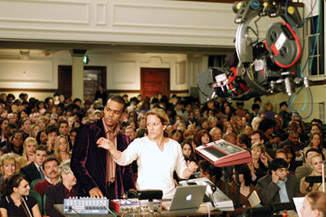Top 10 Film Industry Stories of 2006 #4:
MySpace Marketing Revolutionizes the Industry
By Joel Corcoran
January 2, 2007
BoxOfficeProphets.com

John Tucker had a MySpace page.
In fact, this MySpace page was the only Internet link publicized for the movie. There was no "http://johntuckermustdie-themovie.com" or even a page at the official website for the studio behind the film, Twentieth Century Fox. Instead, if you wanted to learn about the film, you had to visit MySpace. And not only could you learn about the film, if you were a MySpace user, you could add John Tucker as a friend, receive bulletins about the film's release schedule, interact with other characters from the film (who had their own MySpace pages), and discuss the film with other fans in MySpace chat rooms. Fox didn't just throw up a few production stills on MySpace, they created an entire interactive experience at the core of the entire marketing effort for the film. The entire cost for the MySpace-oriented effort was less than the cost of a few primetime TV commercials, but MySpace attracted the eyes of more teenagers than running an ad during every episode of Smallville's entire season.
The collaboration between Twentieth Century Fox and MySpace seemed inevitable. Rupert Murdoch's News Corporation owns both companies, and both Fox and MySpace want to attract people in the highly prized 18- to 34-year-old demographic. Their arrangement around John Tucker Must Die made perfect sense, but the results were completely unexpected. Even Fox executives were surprised at the buzz created around the movie.
When John Tucker Must Die opened third at the box office in late July, advertising executives and marketing professionals within the film industry immediately took notice. And the advertising sales departments at television networks across the country lurched into something approaching blind panic. The movie cost $18.0 million to produce, earned $14.3 million its opening weekend, and went on to gross $58.4 million worldwide. Compare that to the number one movie on the same weekend in July, Miami Vice, which had a $135 million production budget, opened to a soft $25.7 million, and earned $163.8 million worldwide. John Tucker Must Die netted over $40 million on an $18 million investment (an ROI equal to about 220%), while Miami Vice netted slightly under $30 million on a $135 million investment (an ROI of about 22%). Or look at John Tucker Must Die versus The Ant Bully, which opened at fifth at the box office that same weekend. Ant Bully cost about $50 million to make, opened to a paltry $8.4 million, and earned $54.6 million worldwide (an ROI of 9.2%).
Other movies quickly followed John Tucker's lead. Kevin Smith, the director of Clerks II, had his own MySpace page, and the Weinstein Company (the studio behind the film) not only put up a MySpace page for the movie, they ran a contest. The first 10,000 MySpace users who added Clerks II as a friend would have their names listed in the film's credits. Weinstein's marketing department expected the contest to last a week or two, but they reached the 10,000-person limit in less than two hours. The Covenant, Eragon, The Prestige, Marie Antoinette, Flushed Away jumped aboard the MySpace bandwagon pretty quickly, and by Labor Day, it seemed like every movie had its own MySpace page. Even Snakes on a Plane, which defined "Internet buzz" in the movie industry, opted for MySpace page.
One of the films that was best able to leverage its MySpace buzz to box office dollars was the teen-oriented dance flick Step Up. When the trailer for the film was first aired, the natural link to the MySpace page was included at the end, which prompted a bevy of kids to rush to the site to find out more. Dancers were encouraged to submit their own videos, allowing them to potentially win a role in the film itself. With the release of the DVD, many of these clips are included while some of the stars of the film offer commentary on the performances. Thanks to the clever marketing scheme, Step Up was able to leverage a shocking $20.7 million opening before going on to make $65.3 million domestically.
The MySpace movement reached a high point with the release of Borat. Not only did Borat have his own MySpace page (and a brilliantly funny one at that), but MySpace created a distinct "movie space" on its website (http://movies.myspace.com). Fox and MySpace also used the film as the launching pad for a new marketing effort, The Black Carpet. This opt-in program follows the model of MySpace's tremendously popular Secret Shows program for musicians offers MySpace users the opportunity to attend select preview screenings of new movies. Borat opened in theaters on November 3rd, but participants in The Black Carpet were able to attend "secret" preview screenings weeks earlier. About 7,500 MySpace users were able to see the movie in 25 cities in the U.S., Europe, and Australia on September 20th. Fox was able to use these screenings as a way to generate tremendous buzz around the movie, which went on to become one of the most surprising openers of the year. By the time the movie officially opened in theaters, Borat had over 100,000 friends on his MySpace page.
Whether social-networking in general, and MySpace in particular, supplants traditional media-based advertising remains to be seen. However, we can all expect the studios to spend less on TV commercials in 2007 and devote more of their efforts and money to following in Borat's footsteps.